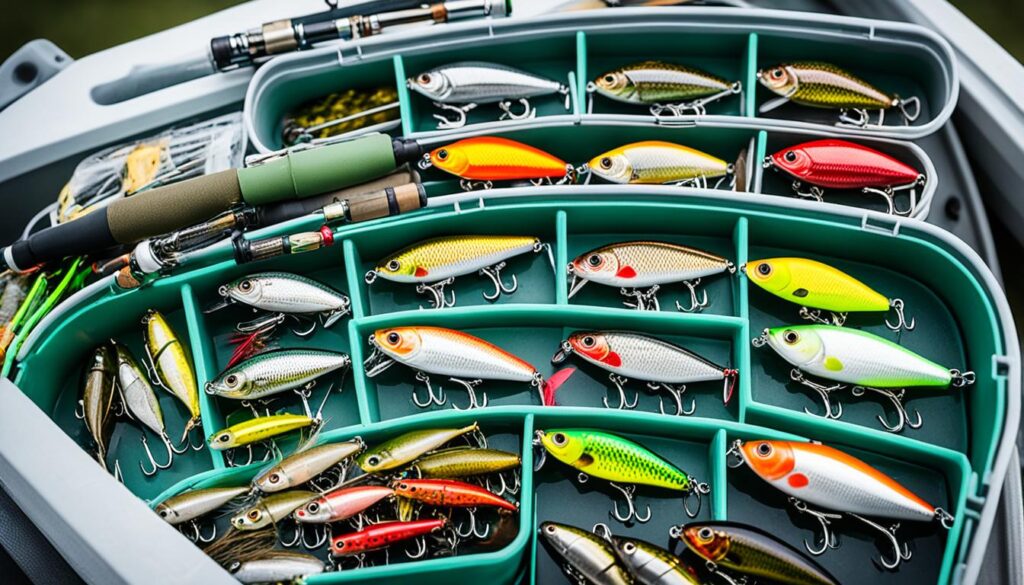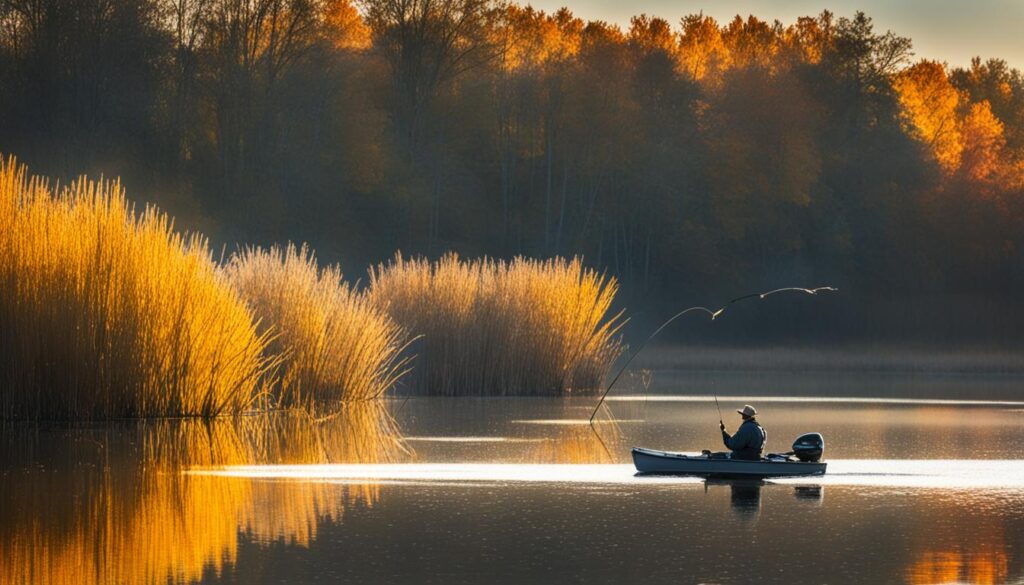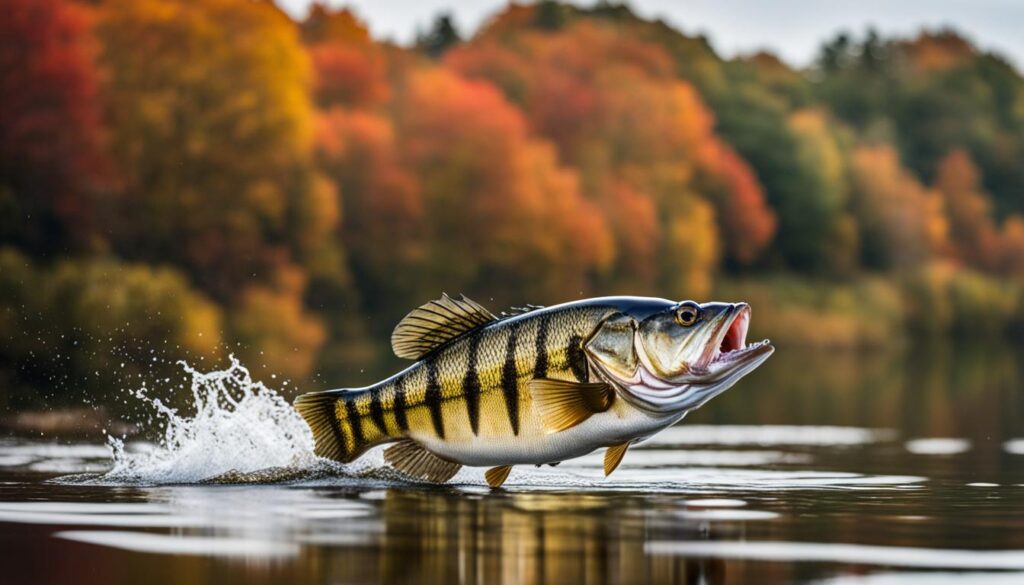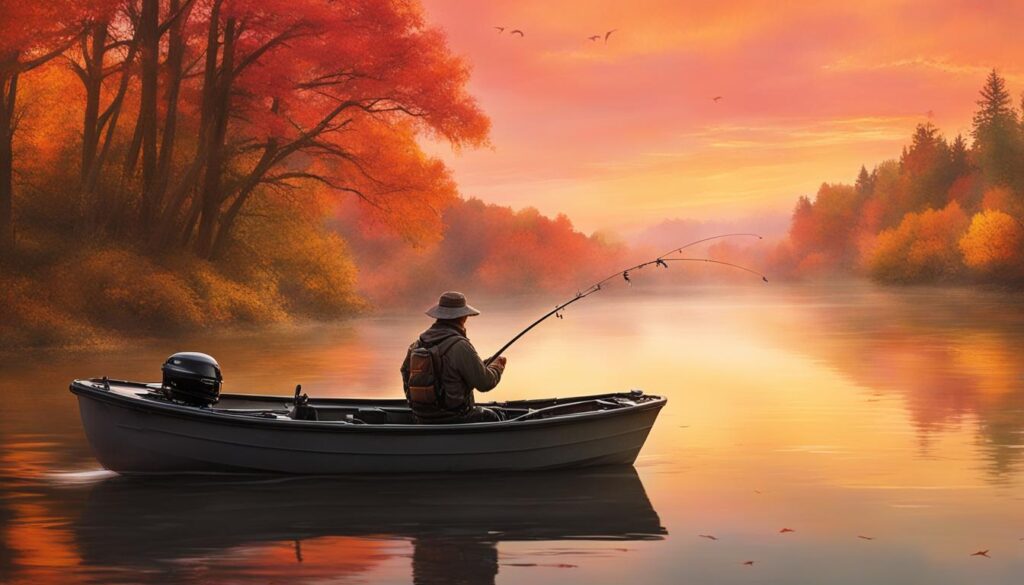Are you ready to maximize your fall bass flipping bite? As the seasons change, so do the patterns of bass behavior. Understanding where to find transition bass in the fall can greatly improve your chances of a successful fishing trip. Whether you’re a seasoned angler or a novice, these fall bass fishing tips will help you target the right areas and increase your chances of hooking into some trophy-worthy bass.
Key Takeaways:
- Transition bass follow a consistent pattern during the fall as they move from spawning to feeding.
- Targeting shallow-water bass requires power fishing techniques such as flipping, punching, and frogging.
- Offshore or ledge fish can be targeted with crankbaits and jigs.
- Understanding bass behavior and identifying key transition areas is crucial for success.
- Experimenting with different techniques and lures will help determine what the bass are biting on any given day.
Power Fishing Transition Bass in Shallow Water
When transition bass move into shallow water during the autumn, power fishing techniques can be highly effective in maximizing bass bites. Flipping, punching, and frogging are popular methods used by anglers to target these bass in the shallows. These techniques allow for precise presentations and can entice aggressive strikes from transitioning bass.
For successful flipping techniques, using the right baits and tackle is crucial. The Bully Wa 2 Frog and the Sweet Beaver are both effective options for flipping in the autumn. These baits mimic natural prey and can attract the attention of hungry bass. To ensure a proper presentation, it is important to pair these baits with the right tackle.
Flipping and Punching Setup:
- 1 oz Tungsten Weight
- Gamakatsu 4/0 Superline Hook
- Peg X Bobber Stopper
By using a 1 oz Tungsten Weight, anglers can effectively penetrate vegetation and reach the target zone where bass are hiding. The Gamakatsu 4/0 Superline Hook provides excellent hook penetration and strength, ensuring a solid hookup when a bass strikes. Adding a Peg X Bobber Stopper helps keep the weight and hook in position, enhancing the overall performance of the flipping setup.
Power fishing techniques such as flipping can be highly rewarding during the autumn season. These techniques allow anglers to cover a lot of water quickly and efficiently, increasing the chances of targeting transitioning bass in shallow water. Experimenting with different baits, tackle setups, and presentations can help anglers find the most effective approach to maximize their bass bites in the fall.
Coming up in Section 3, we will explore the strategies for targeting offshore or ledge fish during the autumn season.
Targeting Offshore or Ledge Fish
If you’re an angler looking to target the group of transition bass that heads offshore, there are several effective lure options that can help you maximize your fall fishing success. The Norman DD-22 Crankbait, Strike King 6XD Crankbait, and Strike King 10XD are all popular choices for targeting offshore or ledge fish. These crankbaits are designed to dive deeper and cover more water, enticing bass that are holding in deeper structures.
When offshore, bass often school up in mega schools, providing a different kind of excitement for anglers. This creates an opportunity to catch multiple bass in one area. Along with crankbaits, additional baits that can be used for both offshore and shallow-water bass include the Dirty Jigs Pitchin’ Jig, Zoom Trick Worm, and Strike King Fat Baby Finesse Worm. These versatile baits give you options for different presentations and increase your chances of enticing bass to bite.

When targeting offshore or ledge fish, it’s important to have the right equipment and presentation. Use a fishing rod with enough backbone to handle larger, deep-diving crankbaits. This will allow you to effectively work the bait and detect bites. Make sure to adjust your presentation based on the water depth and structure you are fishing. Vary your retrieve speed and cadence to imitate injured baitfish and trigger a reaction bite.
Fall Fishing Lure Selection
When selecting lures for targeting offshore or ledge fish, consider the following factors:
- Depth: Choose lures that can reach the desired depth where the bass are holding.
- Baitfish Imitation: Opt for lures that closely resemble the preferred forage of the bass in the area.
- Color: Experiment with different colors to determine which ones the bass are most responsive to.
- Size: Match the size of the lure to the size of the baitfish in the area.
By considering these factors and selecting the appropriate lures, you can increase your chances of success when targeting offshore or ledge fish in the fall.
Understanding Bass Behavior in Spring and Fall
When it comes to fall bass fishing tips, understanding bass behavior is key to improving your fishing success. Bass behavior is influenced by changing water conditions such as temperature, clarity, and current. In the fall, bass become more active as they feed up before the spawn. This is a prime time to target bass and increase your chances of landing a big catch.
One important factor to consider is the effect of low light conditions on bass behavior. During the fall, sunrise and sunset are great times to target bass. Bass are more active and feed more aggressively during these times. The reduced light also provides the advantage of concealment for the bass, allowing them to ambushed their prey more effectively.
Water temperature also plays a significant role in bass behavior.
Bass are most comfortable in water temperatures between 60-75 degrees Fahrenheit. As the water temperature drops in the fall, it triggers the bass to feed up and prepare for the upcoming spawn. By targeting areas with the ideal water temperature range, you increase your chances of finding actively feeding bass.
Understanding these behavioral patterns can greatly improve your fall fishing success. By planning your fishing trips during low light conditions and focusing on areas with the optimal water temperature range, you will be in a better position to capitalize on the feeding frenzy of fall bass.
| Factors | Impact on Bass Behavior |
|---|---|
| Changing water conditions (temperature, clarity, current) | Influences bass activity levels and feeding patterns. |
| Low light conditions (sunrise and sunset) | Triggers increased bass activity and feeding aggression. |
| Water temperature (60-75 degrees Fahrenheit) | Indicates optimal conditions for feeding and bass comfort. |
Where to Fish for Bass in Different Conditions
When it comes to fall bass fishing, understanding where to find the fish is key to a successful outing. Bass can be found in various locations depending on the conditions, and knowing where to look will greatly improve your chances of a productive day on the water.
Seeking out Cover
In the fall, bass seek out cover for protection and ambush opportunities. Look for areas with stumps, timber, grass beds, docks, rocks, and structures like wing dams and rip rap walls. These features provide bass with hiding places and serve as feeding grounds, making them prime areas to target.
Using Depth Changes
Another important factor to consider is depth changes. Bass often relate to drop-offs, ledges, and changes in bottom structure. These transitions in depth not only offer bass a change in hiding spots but also create areas where baitfish are likely to congregate. Keep an eye out for these depth changes and target them with your presentations.
Considering Current Positions
Current can play a significant role in bass behavior and feeding patterns. Understanding how bass position themselves in relation to the current can help you identify productive areas. Look for points, eddies, and areas of slack water where bass can conserve energy while waiting for prey to pass by.
| Fall Bass Fishing Tips | Bass Flipping in Autumn |
|---|---|
| Seek out cover like stumps, timber, grass beds, docks, rocks, and structures | Utilize power fishing techniques such as flipping and frogging |
| Target depth changes, drop-offs, and ledges | Consider the current positioning of bass |
By keeping these factors in mind and adapting your approach accordingly, you’ll be able to pinpoint the most productive areas and increase your chances of landing some quality fall bass.
Best Times to Fish for Bass
The best times to fish for bass are during low light conditions, such as sunrise and sunset. Bass are most active during these times as they have a feeding advantage when they are more concealed.
According to my personal experience, I’ve had great success catching bass in the early morning and late evening hours. The calmness of the pre-dawn water and the fading light of sunset create the perfect conditions for bass to venture out and feed. During these magical hours, the water surface is tranquil, and the bass feel more secure to come out of their hiding spots.
The tranquility of the early morning and the peacefulness of the evening can make you feel like the only soul on the water.
In the fall, bass fishing picks up pace as the early prespawn period commences. This is a time when bass are more aggressive and actively foraging to build up their energy reserves for the upcoming spawn. It’s a prime opportunity to maximize your chances of landing some impressive catches.
Water temperature plays a crucial role in determining bass activity. Bass are most comfortable in water temperatures between 60-75 degrees. As the water cools down in the fall, the bass become more active, making it an ideal time for anglers to head out and enjoy their favorite pastime.
Bite Detection Strategies
To enhance your success during the best times to fish for bass, it’s important to develop effective bite detection strategies. Here are a few tips:
- Pay attention to subtle rod tip movements or line twitches. Sometimes, a bass bite can be so gentle that it’s easy to miss if you’re not focused.
- Use baits with built-in bite indicators, such as those with rattles or vibration, to increase your chances of detecting a bite. These baits can help you feel the slightest nibble or see a line jump as the bass strikes.
- Keep your line tight and maintain direct contact with your lure. This ensures you can feel even the smallest taps or twitches.
- Watch for any line movement, sudden stops, or line swimming sideways. These can all be indications of a bass bite.
By incorporating these strategies into your fishing routine, you’ll be able to detect more bites and increase your success rate on the water.
| Best Times to Fish for Bass | Bite Detection Strategies |
|---|---|
| – Sunrise and sunset | – Pay attention to subtle rod tip movements or line twitches |
| – Early prespawn period in fall | – Use baits with built-in bite indicators |
| – Water temperature: 60-75 degrees | – Keep your line tight and maintain direct contact with your lure |
| – Watch for any line movement, sudden stops, or line swimming sideways |

Best Bass Fishing Techniques
When it comes to fall bass fishing, there are several techniques that can greatly improve your chances of success. By using these popular techniques, you can maximize your fall bass flipping bite and improve your overall fishing success. Let’s explore some of the most effective techniques:
1. Spinnerbaits
Spinnerbaits are versatile lures that can be effective in various fishing conditions. With their flashy blades and skirted bodies, spinnerbaits mimic a baitfish and trigger aggressive strikes from bass. They are particularly effective when fishing in and around cover, such as submerged vegetation and fallen trees.
2. Frogs
Frogs are topwater lures that excel in shallow-water situations, especially when bass are feeding near the surface. By creating a realistic frog-like action, these lures entice bass to strike aggressively. Target areas with thick vegetation, lily pads, and other forms of cover to maximize your chances of success.
3. Ned Rigs
Ned rigs are finesse-style baits that can be highly effective in fall bass fishing. These lures consist of a small, mushroom-shaped jighead and a soft plastic worm. Ned rigs are known for their subtle action, making them ideal for targeting less active or finicky bass. Fish them slowly along the bottom, focusing on areas with structure or cover.
4. Shaky Heads
Shaky heads are another finesse technique that can produce excellent results in the fall. These jigheads feature a small, finesse worm-style bait rigged weedless. Shaky heads are best used in areas with rocky or gravel bottoms. The subtle shaking action mimics a natural prey item and can entice bites from wary bass.
5. Drop Shot Worms
The drop shot technique is a finesse approach that can be deadly in fall bass fishing. A drop shot rig consists of a small hook tied above a weight, with a soft plastic worm attached to the hook. This setup allows the worm to suspend above the bottom, enticing bass to strike. Experiment with different worm colors and sizes to find what works best on any given day.
6. Texas-Rigged Plastic Worms
Texas-rigged plastic worms are a classic bass fishing technique that never goes out of style. This versatile setup is great for targeting bass in various cover and structure types. Whether it’s flipping around docks or dragging the worm along submerged vegetation, Texas-rigged plastic worms can produce bites when other techniques fail.
“Using a variety of techniques allows you to adapt to different fishing conditions and let the bass tell you what they want each day.”
| Technique | Advantages | Disadvantages |
|---|---|---|
| Spinnerbaits | – Versatile – Provokes aggressive strikes – Effective in cover |
– Requires proper retrieval technique |
| Frogs | – Topwater action attracts bass – Effective in shallow water – Triggers aggressive strikes |
– Requires accurate casting |
| Ned Rigs | – Subtle action entices finicky bass – Ideal for less active fish – Effective finesse technique |
– Limited to specific depth ranges |
| Shaky Heads | – Subtle shaking action entices strikes – Effective finesse technique – Great for rocky or gravel bottoms |
– May snag in heavy cover |
| Drop Shot Worms | – Suspended presentation entices bites – Versatile finesse technique – Can be used in different depths |
– Requires finesse presentation |
| Texas-Rigged Plastic Worms | – Versatile technique – Effective in various cover and structures – Classic bass fishing approach |
– Requires proper rigging and presentation |
As with any fishing technique, it’s important to experiment and adapt to the preferences of the bass on any given day. By using a combination of these techniques and adjusting your presentation, you can maximize your fall bass flipping bite and improve your overall fall fishing success.

Now that you’ve learned about some of the best bass fishing techniques for the fall season, it’s time to hit the water and put your knowledge into action. Remember to stay adaptable, be patient, and enjoy the thrill of the chase as you seek out those elusive fall bass.
Bass Fishing Lures
When it comes to bass fishing, having the right lures can make all the difference in your success on the water. Here are some versatile options that will cover most bass fishing situations:
- Texas-rigged plastics: This classic bass fishing lure is incredibly effective year-round. Whether you opt for a soft plastic worm, creature bait, or craw, Texas-rigged plastics can entice even the most finicky bass.
- Spinnerbaits: Ideal for covering water and triggering reaction strikes, spinnerbaits are known for their flash and vibration. They mimic baitfish and are particularly effective in stained water or windy conditions.
- Topwaters: Nothing beats the heart-pounding excitement of a bass exploding on a topwater lure. Whether it’s a buzzbait, popper, or walking bait, topwaters are deadly in low light conditions and when bass are feeding near the surface.
- Lipless crankbaits: These sinking lures are a great choice for covering water quickly. They have a tight wobbling action that mimics a dying shad, making them irresistible to hungry bass.
- Soft-plastic swimbaits: Perfect for imitating injured baitfish, soft-plastic swimbaits are known for their realistic swimming action. You can fish them on a weighted hook or a jighead, depending on the depth and cover you’re targeting.
- Jigs: Jigs are a versatile and effective bait for bass fishing. Whether you’re flipping docks, dragging them along the bottom, or swimming them through cover, jigs are a go-to lure for many anglers.
- Carolina rigs: If you’re targeting bass on the bottom, a Carolina rig is a great choice. This rig consists of a sinker, a leader, and a soft plastic bait. It allows the bait to move freely, making it especially effective for finicky or inactive bass.
The selection of the lure will depend on the conditions and the preferences of the bass. It’s important to have a variety of baits at the ready to adapt to different situations and increase your chances of success on the water.
Comparison of Bass Fishing Lures
| Lure Type | Best Fishing Conditions | Effective Techniques |
|---|---|---|
| Texas-rigged plastics | Any conditions | Pitching, flipping, dragging |
| Spinnerbaits | Stained water, windy conditions | Slow rolling, ripping, burning |
| Topwaters | Low light conditions, surface feeding | Walking, popping, buzzing |
| Lipless crankbaits | Covering water quickly | Burn and kill, yo-yo retrieve |
| Soft-plastic swimbaits | Imitating injured baitfish | Swimming, slow-rolling, hopping |
| Jigs | Various conditions | Flipping, pitching, dragging, swimming |
| Carolina rigs | Bottom fishing | Dragging, hopping, shaking |
Conclusion
Targeting transition bass in the fall can be an exciting and rewarding experience for anglers. To maximize your chances of success, it is crucial to understand the behavior of these fish and identify key transition areas.
Power fishing techniques such as flipping and frogging prove to be highly effective when targeting shallow-water bass during this season. These techniques allow for precise presentations in close quarters, enticing bites from wary bass.
For those who prefer fishing offshore or targeting bass on ledges, crankbaits and jigs are popular lure choices. The Norman DD-22 Crankbait, Strike King 6XD Crankbait, and Strike King 10XD are all excellent options for enticing strikes from offshore bass. Additionally, the Dirty Jigs Pitchin’ Jig, Zoom Trick Worm, and Strike King Fat Baby Finesse Worm are versatile choices that work well for both offshore and shallow-water bass.
As with any fishing, it’s important to experiment with different techniques and lures to determine what the bass are biting on any given day. The key to success lies in adapting to the conditions and adapting your presentation accordingly. So get out there, explore different techniques, and make the most of your fall bass flipping bite!
FAQ
Where should I target transition bass in the fall?
Transition bass can be found along their route from spawning to feeding. They can be targeted in shallow water or offshore, depending on their movement. Shallow-water bass can be targeted with power fishing techniques like flipping and frogging, while offshore or ledge fish can be targeted with crankbaits and jigs.
What are some tips for power fishing transition bass in shallow water?
To power fish transition bass in shallow water, use techniques like flipping, punching, and frogging. Effective baits for this approach include the Bully Wa 2 Frog and the Sweet Beaver. You will need a 1 oz Tungsten Weight, a Gamakatsu 4/0 Superline Hook, and a Peg X Bobber Stopper.
How can I target offshore or ledge fish in the fall?
To target offshore or ledge fish in the fall, use crankbaits and jigs. Effective options include the Norman DD-22 Crankbait, Strike King 6XD Crankbait, and Strike King 10XD. The Dirty Jigs Pitchin’ Jig, Zoom Trick Worm, and Strike King Fat Baby Finesse Worm are versatile baits for both offshore and shallow-water bass.
How can I improve my fall fishing success by understanding bass behavior?
Bass become more active in the fall as they feed up before the spawn. They are most comfortable in water temperatures between 60-75 degrees. Bass are more active during low light conditions, such as sunrise and sunset. Understanding these behavioral patterns can help improve your fall fishing success.
Where can I find bass in different fishing conditions?
In the fall, bass can be found in cover such as stumps, timber, grass beds, docks, rocks, and structures like wing dams and rip rap walls. They also relate to depth changes and cover, using them to conceal themselves and as feeding grounds. The current positions of fish can also be a determining factor when fishing a body of water.
When are the best times to fish for bass?
Bass are most active during low light conditions, such as sunrise and sunset. These times provide a feeding advantage for bass as they are more concealed. Bass fishing also picks up in the spring, with the early prespawn period being a time when bass are more aggressive. Bass are most comfortable in water temperatures between 60-75 degrees.
What are the best bass fishing techniques?
Some effective bass fishing techniques include using spinnerbaits, frogs, Ned rigs, shaky heads, drop shot worms, and Texas-rigged plastic worms. These techniques allow for a variety of presentations and can be adapted to different fishing conditions. It’s important to experiment with different techniques to determine what the bass are biting on any given day.
What are some popular bass fishing lures?
A handful of versatile lures for bass fishing include Texas-rigged plastics, spinnerbaits, topwaters, lipless crankbaits, soft-plastic swimbaits, jigs, and Carolina rigs. The selection of the lure will depend on the conditions and the preferences of the bass. It’s important to have a variety of baits at the ready to adapt to different situations.
How can I maximize my fall bass flipping bite?
To maximize your fall bass flipping bite, make sure to use the right baits and tackle. Effective baits for flipping include the Bully Wa 2 Frog and the Sweet Beaver. You will need a 1 oz Tungsten Weight, a Gamakatsu 4/0 Superline Hook, and a Peg X Bobber Stopper. These baits and tackle can help increase your chances of getting more bass bites.
